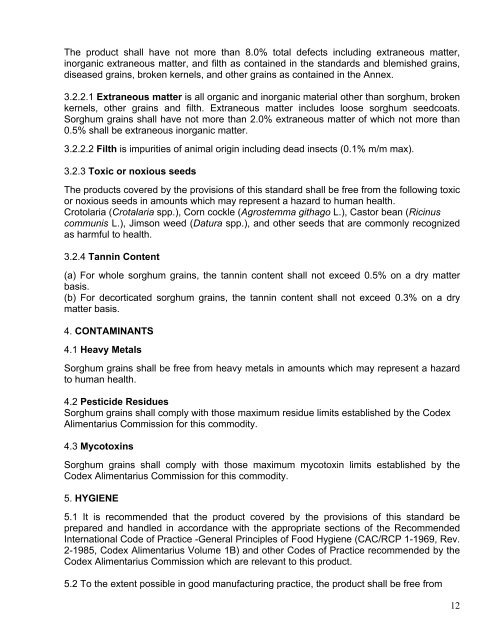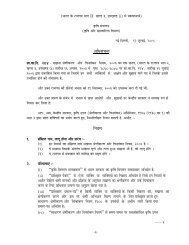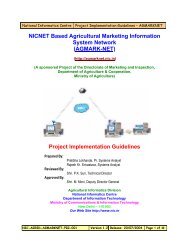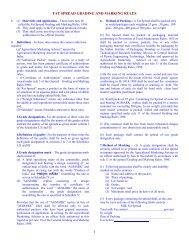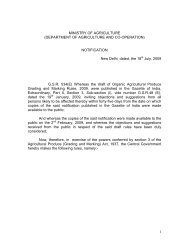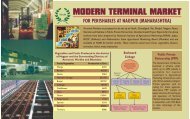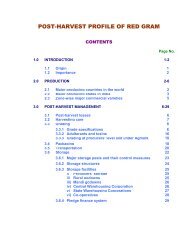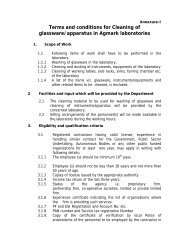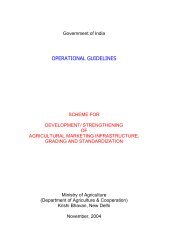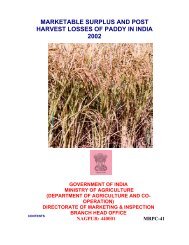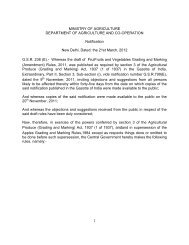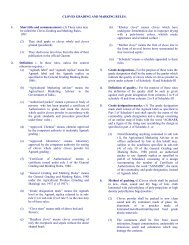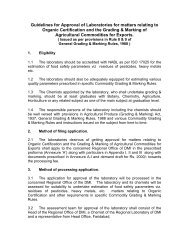POST HARVEST PROFILE OF JOWAR - Agmarknet
POST HARVEST PROFILE OF JOWAR - Agmarknet
POST HARVEST PROFILE OF JOWAR - Agmarknet
You also want an ePaper? Increase the reach of your titles
YUMPU automatically turns print PDFs into web optimized ePapers that Google loves.
The product shall have not more than 8.0% total defects including extraneous matter,<br />
inorganic extraneous matter, and filth as contained in the standards and blemished grains,<br />
diseased grains, broken kernels, and other grains as contained in the Annex.<br />
3.2.2.1 Extraneous matter is all organic and inorganic material other than sorghum, broken<br />
kernels, other grains and filth. Extraneous matter includes loose sorghum seedcoats.<br />
Sorghum grains shall have not more than 2.0% extraneous matter of which not more than<br />
0.5% shall be extraneous inorganic matter.<br />
3.2.2.2 Filth is impurities of animal origin including dead insects (0.1% m/m max).<br />
3.2.3 Toxic or noxious seeds<br />
The products covered by the provisions of this standard shall be free from the following toxic<br />
or noxious seeds in amounts which may represent a hazard to human health.<br />
Crotolaria (Crotalaria spp.), Corn cockle (Agrostemma githago L.), Castor bean (Ricinus<br />
communis L.), Jimson weed (Datura spp.), and other seeds that are commonly recognized<br />
as harmful to health.<br />
3.2.4 Tannin Content<br />
(a) For whole sorghum grains, the tannin content shall not exceed 0.5% on a dry matter<br />
basis.<br />
(b) For decorticated sorghum grains, the tannin content shall not exceed 0.3% on a dry<br />
matter basis.<br />
4. CONTAMINANTS<br />
4.1 Heavy Metals<br />
Sorghum grains shall be free from heavy metals in amounts which may represent a hazard<br />
to human health.<br />
4.2 Pesticide Residues<br />
Sorghum grains shall comply with those maximum residue limits established by the Codex<br />
Alimentarius Commission for this commodity.<br />
4.3 Mycotoxins<br />
Sorghum grains shall comply with those maximum mycotoxin limits established by the<br />
Codex Alimentarius Commission for this commodity.<br />
5. HYGIENE<br />
5.1 It is recommended that the product covered by the provisions of this standard be<br />
prepared and handled in accordance with the appropriate sections of the Recommended<br />
International Code of Practice -General Principles of Food Hygiene (CAC/RCP 1-1969, Rev.<br />
2-1985, Codex Alimentarius Volume 1B) and other Codes of Practice recommended by the<br />
Codex Alimentarius Commission which are relevant to this product.<br />
5.2 To the extent possible in good manufacturing practice, the product shall be free from<br />
12


